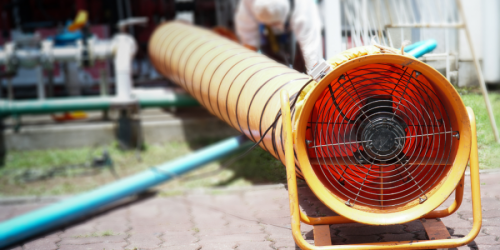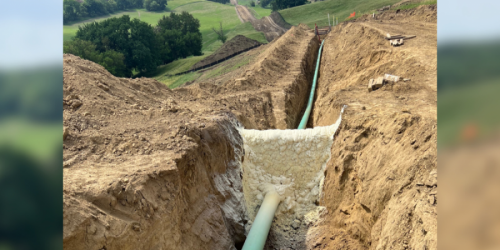Q&A Forums
capping a mine shaft with foam Post New Topic | Post Reply
| Author | Comments |
|---|---|
|
Jeff Pilapil
Posted: Jul 01, 2010 04:02 PM
|
capping a mine shaft with foam
I looked at a project today at an old copper mine that dates back to the 1800s and is now an EPA superfund site due to leaching from the old tailings. At the very top of the hill (via an access road/path more suited to goats and dirtbikes than my 28 foot gooseneck rig) is a 16'X16' opening to a +200' vertical shaft that is to be sealed off. The EPA engineers have suggested that the wooden platform that covers the hole to be covered with 16" of foam, 3' of concrete, & 10-15' of soil in order to create a permanent seal. The purpose of the foam in this application is not so much a seal for moisture or air or thermal barrier but rather to distribute the weight of the strata above and protect the platform below the foam. Initially the client inquired about 2# CC foam but after I described the difference in compressive strength between 2# and 3# foams, they opted for the stronger material. I have a few questions of my own regarding this novel application and welcome any other input or insight anyone might have.1)installing 12" would use 1 set, 16" would necessitate another set of material & leave 1/2 to 2/3 of a set of material extra that doesn't have an immediate use. How significant of a difference in performance do you foresee between 12" and 16" installed in this app? |
|
SPFer
Posted: Jul 02, 2010 06:01 AM
|
About 1/4. |
|
mason
Posted: Jul 02, 2010 11:46 AM
|
The US Bureau of Land Management has been using polyurethane foam (pour in place) for many years to seal abandoned mines. There is a government specification for this practice. Some of the foam suppliers that have been around a few years may have this specification in their files. Or do a google search for the specification. The foam used is typically a 2 lb density, pour in place so that you can building the thickness without having a problem with exothermic heat. A foot of foam has quite a lot of structural strength. The important factor is to make sure the foam is well adhered to the sides of the opening and the opening is sized so that it gets narrower towards the center and spreads out at the top. That way the foam can sit on itself and add additional support. |
|
mason
Posted: Jul 02, 2010 12:05 PM
|
Here is a good article on using polyurethane foam to seal mines. http://www.nature.nps.gov/geology/aml/amlreports/puf.pdf |
|
Posted: Jul 03, 2010 07:40 AM
|
mason,,saw a fair amount of exotherm while pouring into floatation vessels...like 185 at the surface scan,,,obviously higher internal... it required multiple lifts,,just as spray applied... 'dude |
|
mason
Posted: Jul 04, 2010 10:24 PM
|
dude, Just like in sprayfoam, pour foam has varying rise and set times. Most pour foam has a cream time of 20 to 30 seconds and a rise and set time of 1 to 2-1/2 minutes. But the foam I have used for large volume pour applications such as barge filling has a cream time of 2 minutes and a rise and set time of over 6 minutes. You can pour a foam so long as it is within the cream time, but once it starts to rise you need to stop or it will negatively affect its cell structure and potentially cause too much exothermic heat. |





























